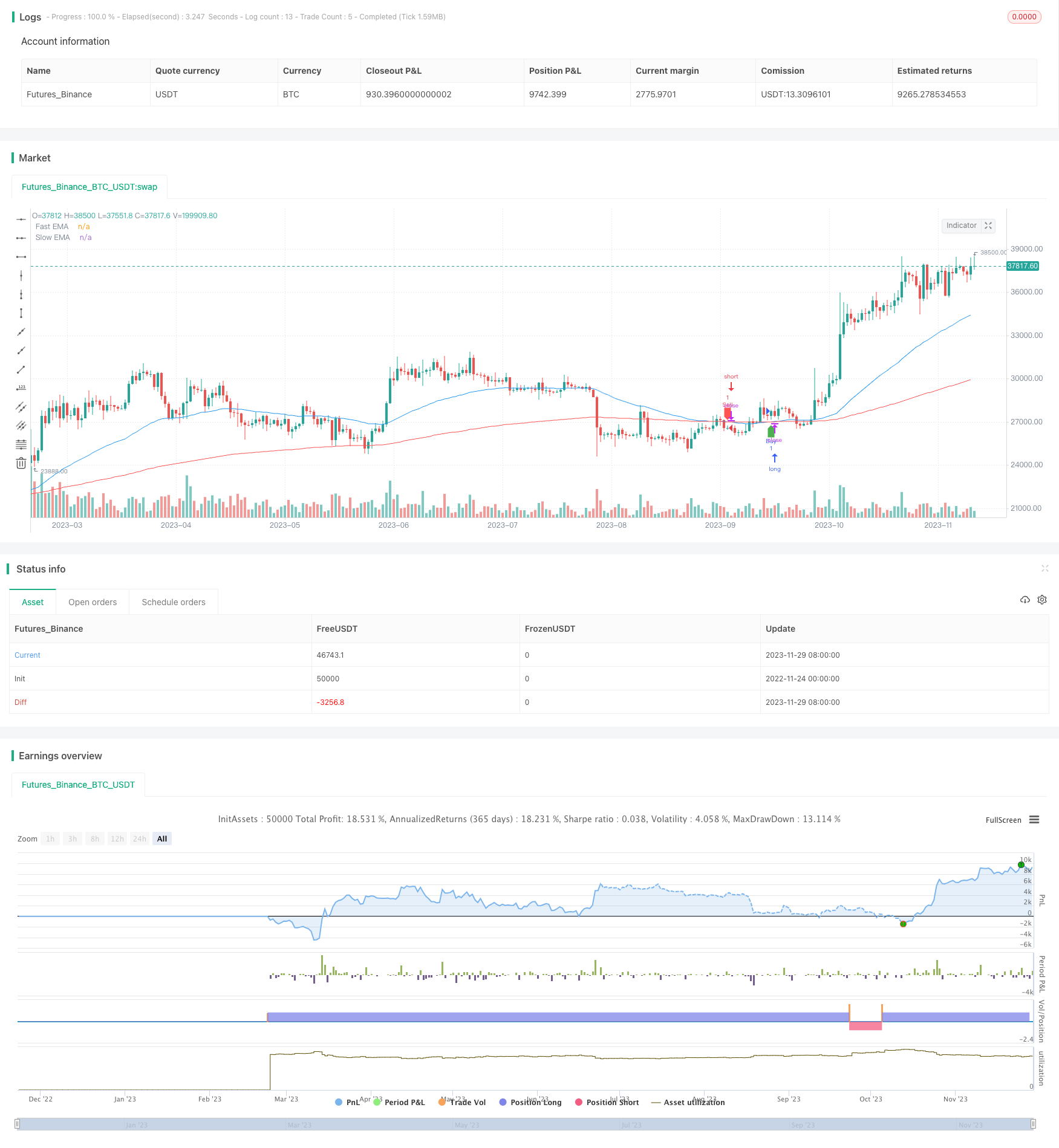
概述
本策略基于两个指数移动平均线(EMA)的金叉与死叉来产生交易信号。具体而言,该策略计算50周期EMA和200周期EMA,当短期EMA(50周期)上穿长期EMA(200周期)时,产生买入信号;当短期EMA下穿长期EMA时,产生卖出信号。这可以有效捕捉股票价格的短期和长期趋势变化,形成动量型的交易策略。
策略原理
计算两条指数移动平均线:50周期EMA和200周期EMA。EMA赋予最近数据更大权重,对短期价格变动更敏感。
确定交易信号:
- 买入信号:短期EMA上穿长期EMA,表示短期趋势转为上升。
- 卖出信号:短期EMA下穿长期EMA,表示短期趋势转为下降。
根据信号执行交易:买入信号时做多,卖出信号时做空。
在图表上绘制EMA和交易信号,便于形成直观判断。
优势分析
该策略具有以下优势:
捕捉大趋势的反转,特别适合趋势和盘整市。效果较好。
决策规则简单清晰,容易实现与回测。
EMA平滑价格数据,有利于识别趋势信号,滤除噪音。
可调整EMA周期,适应不同持仓周期。
结合其他指标可进一步过滤信号,优化策略。
风险分析
该策略也存在一些风险:
在震荡市中可能产生较多错误信号和过多无效交易。
只依赖单一指标规则,Robust性较差。
未考虑止损规则,存在亏损扩大的风险。
EMA延迟性可能错过价格变化的最佳参与点位。
需回测确定最佳参数,实盘表现可能与回测结果有差异。
对应风险控制与优化措施包括:结合其他指标过滤信号、设置止损机制、引入机器学习模型等。
优化方向
该策略可从以下几个方面进行优化:
结合其他指标(如MACD、KD等)实现多因子模型,提高策略的Robust性。
加入止损机制。如设定固定百分比止损或随动止损。控制单次交易最大损失。
使用机器学习方法获得最优参数。改进信号判断规则。提高策略的稳健性。
根据回测结果设定最优的EMA周期组合。根据市场环境调整参数。
评估交易成本影响。加入滑点模型与手续费考量。优化仓位管理。
总结
本策略整体而言是一种较为经典简单的突破型交易策略。基于EMA指标的金叉死叉形成决策规则。虽具有一定的时效性,但也存在一些缺陷与可优化空间。如何改进信号判断、控制风险、动态调参等,是后续需要重点考虑的方面,这将大大增强该策略在实盘中的稳定盈利能力。
/*backtest
start: 2022-11-24 00:00:00
end: 2023-11-30 00:00:00
period: 1d
basePeriod: 1h
exchanges: [{"eid":"Futures_Binance","currency":"BTC_USDT"}]
*/
//@version=5
strategy("EMA Golden Crossover Strategy", overlay=true)
// Input parameters
fastLength = input(50, title="Fast EMA Length")
slowLength = input(200, title="Slow EMA Length")
// Calculate EMAs using ta.ema
fastEMA = ta.ema(close, fastLength)
slowEMA = ta.ema(close, slowLength)
// Plot EMAs on the chart
plot(fastEMA, color=color.blue, title="Fast EMA")
plot(slowEMA, color=color.red, title="Slow EMA")
// Strategy logic
longCondition = ta.crossover(fastEMA, slowEMA)
shortCondition = ta.crossunder(fastEMA, slowEMA)
// Execute orders
if (longCondition)
strategy.entry("Buy", strategy.long)
if (shortCondition)
strategy.entry("Sell", strategy.short)
// Plot buy and sell signals on the chart
plotshape(series=longCondition, title="Buy Signal", color=color.green, style=shape.labelup, location=location.belowbar)
plotshape(series=shortCondition, title="Sell Signal", color=color.red, style=shape.labeldown, location=location.abovebar)